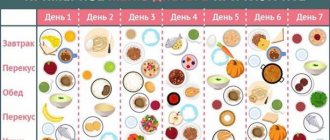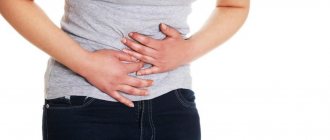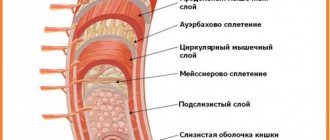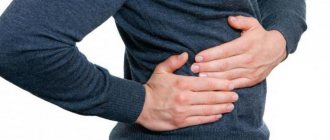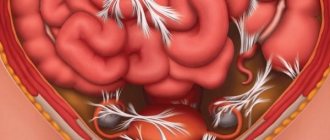What is abdominal pain
Abdominal pain is not an independent disease. They indicate any pathological processes occurring in the peritoneal cavity. The abdomen is bounded above by the costal arches, and below by the symphysis pubis. When pathological processes occur, unpleasant sensations can radiate to these areas. This complicates the process of establishing the exact cause of the symptom complex. Therefore, for diagnosis it is necessary to use several examination methods.
Acute abdominal pain occurs with vascular pathologies or diseases of the peritoneum. For example, vascular thrombosis, bleeding, rupture of the spleen and intestinal pathologies.
Any discomfort in the abdominal area can be regarded as abdominal pain syndrome.
Sources
- Abdominal pain - children under age 12, MedlinePlus - https://medlineplus.gov/ency/article/007504.htm
- Chronic Abdominal Pain and Recurrent Abdominal Pain, Merck Manual - https://www.merckmanuals.com/professional/gastrointestinal-disorders/symptoms-of-gi-disorders/chronic-and-recurrent-abdominal-pain#v887311
- Acute Abdominal Pain, Merck Manual - https://www.merckmanuals.com/professional/gastrointestinal-disorders/acute-abdomen-and-surgical-gastroenterology/acute-abdominal-pain
- Abdominal Pain in Elderly Persons, last reviewed on July 2020, Medscape - https://emedicine.medscape.com/article/776663-overview#showall
- Abdominal Pain: What You Should Know, WebMd - https://www.webmd.com/pain-management/abdominal-pain-causes-treatments#1
- Clinical Methods: The History, Physical, and Laboratory Examinations. 3rd edition https://www.ncbi.nlm.nih.gov/books/NBK412/
- ABDOMINAL PAIN By Lawrence R. Schiller, MD, Baylor University Medical Center Dallas, Texas— https://s3.gi.org/patients/gihealth/pdf/aps.pdf
- Factors Affecting Mortality and Morbidity in Patients With Peptic Ulcer Perforation, Medscape - https://www.medscape.com/viewarticle/555197_3
Types of pain and their characteristic signs
According to the mechanism by which sensations arise, there are several types.
Visceral pain. Occurs in a parenchymal or hollow organ. May be associated with injury, overextension, inflammation, or problems in the circulatory system. Visceral type pain is observed in organic or functional conditions. In this case, signs of nausea, stool retention, and vomiting occur. Other symptoms include fever and bloating.
Sharp sensations can be accompanied by autonomic disorders. The person experiences fear, rapid heartbeat, sweating, dizziness and pallor.
Somatic pain. It is also called parietal. Such sensations occur when the abdominal cavity is irritated. Sometimes it begins with inflammation in the internal organs, then the layers of the peritoneum are involved in the process. The pain increases and becomes localized. The sensations intensify.
Radiating pain. Similar sensations occur in an area of high sensitivity of the skin, the innervation of which is carried out by the same section in the spinal cord as the affected organ.
Psychogenic pain. Occurs if the functioning of the central mechanisms for controlling pain sensitivity is disrupted. Organic pathological processes do not occur in the peritoneum. The sensations are long-lasting, constant, without exacerbations.
According to frequency, cramping pains, which are also called spasmodic, are also distinguished. They occur at regular intervals and can last seconds or hours. Typical for pathologies of the biliary tract, intestinal colic.
Spastic pains come in different localizations:
- epigastric - in the solar plexus area;
- in the right or left hypochondrium - with pathologies of the gallbladder, liver, with an inflammatory process in the pancreas;
- in the navel area - with a duodenal ulcer;
- in the ileum region - when the ovaries, cecum or sigmoid colon hurt.
Treatment of abdominal pain
To treat abdominal pain, therapy for the underlying disease is necessary. For chronic diseases of the gastrointestinal tract that do not require surgical intervention, you should consult a gastroenterologist. However, the main difficulty is the treatment of acute surgical pathologies that pose a threat to the patient’s life.
The chances of survival in a patient with an acute abdomen depend on the time elapsed from the onset of pain to surgery and the age of the patient. For example, with a gastric ulcer, perforation or perforation of the ulcer is possible. Through a through hole in the wall of the organ, gastric juice containing hydrochloric acid enters the abdominal cavity, causing inflammation of the peritoneum (chemical peritonitis). As a result, suddenly, against the background of complete health, severe pain occurs, described by patients as a blow to the stomach with a dagger. The entry of microflora from the lumen of the gastrointestinal tract into the abdominal cavity accelerates the inflammatory process.
In patients over 65 years of age, mortality from peritonitis can reach 40%. Regardless of age and surgical treatment performed, if 24 hours or more have passed since the onset of pain, death is possible in 20% of patients. In some groups of patients, mortality reaches 70% (age over 65 years, late diagnosis and treatment, shock). The attitude towards abdominal pain is well described by the saying “Periculum in mora”, which is translated from Latin as “Delay is like death.”
Causes of pain
Main causes of pain:
- Extra-abdominal. For myocardial infarction, pleurisy, pneumonia, anemia, endocrine and hormonal disorders, as well as osteochondrosis. Most of these painful sensations are referred.
- Intra-abdominal. These sensations indicate that an inflammatory process is occurring in the human body, spastic sensations, stretching, and problems with blood circulation are observed. Such sensations also occur with growths in the peritoneal cavity. Visceral pain may be due to stomach disease.
The causes of unpleasant sensations can be pathological or non-pathological processes.
Non-pathological include:
- Wrong diet. For example, there are too many spicy foods and carbohydrates in the diet.
- Taking medications. Some tablets have a negative effect on gastrointestinal motility and mucous membranes.
- Menstruation. Systematic pain is caused by temporary endometrial ischemia and myometrial spasm.
- Unpleasant sensations in the stomach in children. Up to a year, the sensations are due to the immaturity of the digestive system. Up to 3 years of age, processes of a psychological nature or pathology develop due to errors in the diet.
- Pain during pregnancy. Caused by sprained ligaments, divergence of the symphysis pubis, joint surfaces, or tension of the skin.
Pathological factors:
Classification of abdominal pain
It is generally accepted to divide abdominal pain into acute and chronic (recurrent). Acute pain occurs suddenly, against the background of complete health. Chronic refers to painful sensations in the abdomen that occur constantly or periodically for more than 3 months.
In addition, pain can be divided into functional and organic:
- Functional is called pain in the projection of the abdomen, lasting more than 6 months, arising in response to stress, depression, psychological problems, nervous tension, but not associated with any disease;
- Organic pain always has a basis in the form of one pathology or another.
Variability of pain syndrome in abdominal pathologies
There are many different types of abdominal pain, differing from each other in nature, intensity, onset, radiation to other parts of the body, factors that provoke and alleviate pain. Knowledge of the characteristics of pain syndrome in a particular disease allows us to establish a preliminary diagnosis with 80% accuracy.
- Nature of pain:
- Cutting, sharp (dagger)
- Cramping
- Bursting
- Pulling
- Aching
- Stabbing
- Burning
- Twisting
- Beginning of pain:
- Sudden
- Gradually progressive
- Pain intensity:
- Moderate
- Expressed
- Intense, intolerable
- Characteristics of pain over time:
- Constant
- Paroxysmal, periodically changing over time from minimum to maximum
- Migration of pain:
- Without moving, in one place of the abdomen
- Migrating pain, starting at one point and reaching maximum intensity at another
- Radiation of pain:
- To the right shoulder, neck
- In the perineum, in the sacrum, in the thigh
- In the heart area and lower back
- Factors that provoke or alleviate pain:
- Eating
- Starvation
- Body position
- Vomit
- Defecation
- Urination
- Taking medications
- Associated symptoms:
- Nausea, vomiting
- Jaundice
- Increased body temperature, fever
- Diarrhea, constipation
- Tarry stool
- Frequent urination
- Blood in urine, stool
- Bloating
When to see a doctor and diagnosis of the causes of pain
You should contact specialists in the following cases:
- Increased discomfort in the abdomen. Abdominal pain syndrome is accompanied by tachycardia, dizziness, weakness throughout the body, a sharp decrease in pressure, blood in the stool or vomiting.
- Viral or bacterial infection. In this case, discomfort occurs along with chills, fever, and diarrhea.
- Acute abdominal discomfort, in which the patient is forced to look for the most comfortable position. Accompanied by stool retention and may be life-threatening.
- Local or widespread peritonitis. Characterized by tension in the abdominal muscles.
It is not always possible to determine the source of pain. This makes it difficult to find out the exact cause. Examination data and patient complaints are not enough; diagnostics are required, especially if the symptom is chronic.
Sometimes laboratory and instrumental diagnostic methods are required:
Diagnostics
1. All women of reproductive age must undergo a biochemical test to determine pregnancy.
2. Urinalysis helps diagnose genitourinary tract infection, pyelonephritis and urolithiasis, but is nonspecific (for example, in acute appendicitis, pyuria may be detected).
3. With inflammation, as a rule, there is leukocytosis (for example, with appendicitis, diverticulitis), however, a normal blood test does not exclude the presence of an inflammatory or infectious disease.
4. Results of liver function tests, amylase and lipase may indicate pathology of the liver, gallbladder or pancreas.
5. Visualization methods:
— if a biliary tract disease, abdominal aortic aneurysm, ectopic pregnancy or ascites is suspected, abdominal ultrasound is the method of choice;
— CT scan of the abdominal cavity quite often makes it possible to make the correct diagnosis (nephrolithiasis, abdominal aortic aneurysm, diverticulitis, appendicitis, mesenteric ischemia, intestinal obstruction);
— plain radiography of the abdominal cavity is used only to exclude perforation of a hollow organ and intestinal obstruction;
— ECG to exclude myocardial ischemia.
Symptoms
Due to a sharp narrowing of the vascular lumen, blood flow to the brain decreases, and characteristic signs of cerebral vascular spasm appear. First, a diffuse “squeezing” headache occurs, radiating to the eye sockets. Often an attack begins after physical stress, a sleepless night, or stress. Weather dependent people react to weather changes this way. In addition to painful sensations, dizziness and nausea (even attacks of vomiting) appear. Cognitive functions are depressed, noise appears in the ears, and spots appear in front of the eyes.
The latter phenomenon is caused by circulatory disorders in the ophthalmic artery associated with the cerebral ones. Therefore, with vasospasm, the tone of the eye muscles changes and the blood supply to the retina deteriorates. Due to this, the patient cannot focus his vision and complains of darkening and flickering of black dots before the eyes. In addition, dysfunction of the autonomic nervous system negatively affects the condition of the blood vessels of the whole body: pressure increases or decreases, sweating increases, the face turns red, and sweating increases.
Spasmodic pain in the head
Pain in the head occurs after thirty years, when we are still young and think about diseases. Common causes include lack of sleep, stress and overwork. Osteochondrosis often provokes spasms. The main reason lies in the disruption of blood supply to the brain. Other possible reasons include:
- problems with the thyroid gland;
- heart and kidney disease;
- artery damage;
- vascular dystonia;
- vascular layer defects
- brain tumor
Risk groups include:
- patients with diabetes mellitus;
- people whose immediate family members have had a heart attack or stroke;
- alcoholics and heavy smokers;
- patients with angina pectoris and hypertension;
- thrombosis
Symptoms include:
- headaches and dizziness;
- fatigue and decreased performance;
- nausea;
- speech disorders;
- pain on one half of the body;
- tinnitus and disorientation;
- memory problems
Severe spasms can indicate intracranial hemorrhage, when a person, while conscious, chews food poorly, has difficulty answering questions and pronouncing words in a whisper.


